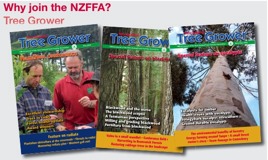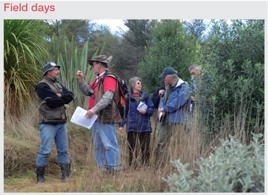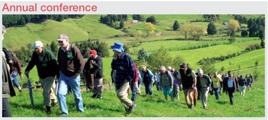One Billion Trees - our forest future
Julie Collins, New Zealand Tree Grower May 2019.
Last year, the government launched the One Billion Trees programme. In that time Te Uru Rakau – Forestry New Zealand was created to lead a strengthened focus on forestry. Since then a lot has happened. We have launched the Crown Forestry Joint Ventures to support planting commercial plantation forests on private land, created the Matariki Tu Rakau community planting initiative to commemorate New Zealand’s service men and women, boosted funding for regional councils with our Hill Country Erosion Programme to treat erosion-prone land, produced the final funding round for the Afforestation Grant Scheme and most recently, launched the new One Billion Trees fund.
The One Billion Trees programme is the government’s primary method for its aim of planting a billion trees over 10 years. The vision is to transform New Zealand’s forests, to improve the economic performance of the regions, the social and cultural outcomes for people, and the quality of the environment. Added to this is a range of objectives, including sustainable economic growth in the regions, providing opportunities for Maori to maximise the potential of their land and resources, protecting and improving soil and water quality, meeting the climate change commitments and increasing native biodiversity.
One Billion Trees is not just about the numbers. To achieve the objectives we need to make sure the right trees are planted in the right place for the right purpose. To do this we want to see a broad range of exotic and native trees established for permanent and plantation forests. Trees need to be suitable for the site and integrated into existing landscapes. The programme does not encourage wholesale land-use conversion. We also want to see planting which is well planned and considers the long-term use of the trees.
None of this will happen by itself and to kick-start new tree planting the government launched the One Billion Trees fund at the end of last year. The fund is an investment in tree planting of $240 million over three years allocated from the Provincial Growth Fund. The Afforestation Grant Scheme, which this fund replaces, allocated $20 million over five years, so this shows the magnitude of opportunity which the One Billion Trees fund presents.

The One Billion Trees fund
The One Billion Trees fund is made up of two distinct pools of funding which work together to incentivise tree planting. One of these pools is grants for trees, and the other is partnerships using co-funding to help get trees in the ground. The new grant scheme is designed to be much more flexible than previous ones which you might be familiar with, such as the Afforestation Grant Scheme. Grants are now available for larger planting projects and can be used for planting and for assisted native reversion projects.
Partnership co-funding is available for projects which will help get trees in the ground and support the right tree in the right place for the right purpose. We want to invest in projects which will see wider benefits for communities, regions and New Zealand, rather than scaling up individual businesses. There are main areas we are looking to invest in, including research and innovation, labour and skills, information and advice. The aim is to remove barriers to planting and support land owners to make well-informed decisions. Partnership co-funding can also be used to support large or catchment-scale native restoration projects in conjunction with grants.
Grants for trees
In setting up the new grant scheme, we took on board a lot of the feedback we had received from land owners about what works and what does not work for them.
Ministers were also very keen on incentives to plan more native trees using the new grant scheme to achieve broader biodiversity. What we have created is a scheme which is more flexible than what we have had in the past, with the aim of two thirds of the fund being focused on native tree planting. There are six features of the new grant scheme which will make it an attractive option for many.
Simple eligibility criteria
Eligibility has been broadened so that much more land is eligible for a grant than under some of our previous schemes. In general, your land needs to meet three eligibility criteria −
- You first need to own the area of land or have the right to plant on it
- Second, the area you are wanting to establish cannot already be in another related government scheme such as the Hill Country Erosion Fund
- Finally, the area cannot be in forest now or have been in forest in the five years before you apply. The presence of forest is determined using the ‘forest land’ definition which you can find more information about on the Te Uru Rakau website.
Your proposed project also needs to meet three eligibility criteria −
- First, the trees you are establishing must be capable of reaching five metres in height at maturity in that location, although trees planted for the purposes of fruit and nut crops are not eligible
- Second, your proposed planting density should be in line with general good practice for your activity and will probably meet a minimum of 750 stems a hectare at establishment with at least this many alive and thriving two to 12 months after planting
- Finally, your proposed project must be capable of reaching an average minimum canopy width at maturity of 30 metres although an exception to this is riparian planting which can be narrower.

| Category | Size | Base rate/ha | Top-up/ ha | |||
|---|---|---|---|---|---|---|
| Erosion-prone land | High land preparation costs | Fencing | ||||
| Native Planting | 1ha - 300ha | $4000 | Up to $500 | Up to $500 | ||
| Native Reversion | 5ha - 300ha | $1000 | Up to $500 | Up to $500 | ||
| Mānuka/Kānuka Planting | 5ha - 300ha | $1800 | Up to $500 | NA | ||
| Exotic Planting | 5ha - 300ha | $1500 | Up to $500 | NA | ||
Flexible funding options
Rather than a single grant rate for all species, the grant scheme has four different grant categories which broadly reflect the different costs of establishment for different activities. In addition, some projects may be eligible for top-up funding to help get them succeed. Of the four different base categories each with a different grant rate −
- The first category is native planting which has a base grant rate of $4,000 a hectare for projects which aim to establish a native forest for a range of uses including ecological restoration or timber production
- The second category is native reversion which has a base category of $1,000 a hectare for projects helping with the reversion to native forest cover
- The third category is manuka/kanuka planting which has a base rate of $1,800 a hectare for projects which intend to only use these species, such as plantations
- The final category is exotic planting which has a base rate of $1,500 a hectare.
There are also two top-ups available in certain circumstances The first top-up is up to $500 a hectare for projects with higher establishment costs, either because the land is erosion prone or because it has challenging land preparation. This top-up is only available in some locations. The second top-up is up to $500 a hectare towards the cost of fencing for native planting and native reversion projects to help protect these blocks from browsing animals.
Open all year
The previous grant schemes operated on annual rounds and were only open for a few months each year. We received strong feedback from land owners and others that it was a challenge to get the application in on time. Therefore, under the One Billion Trees fund, you can make an application at any time. The aim is to process complete applications within two months.
Focus on success
A critical part of the application is a credible management plan. The management plan will have details about the objective of your project, what site preparation you will undertake, what species you will be planting and the proposed planting density, what maintenance you will do after planting, and how you will manage the project over the life of the contract.
The management plan gives Te Uru Rakau confidence that you know what you are doing and that the project is likely to succeed. A farm environment plan which recommends tree planting or reversion on that block, or letter of support from your regional council, will help your application, but is not a requirement.
Flexible project management
As much as we would like it to be easy, establishing trees is not always straight forward. The new grant scheme is more in tune with the realities of a planting project in a number of ways.
Payments are made at certain milestones. The term of the contract is 10 years and payments are made at specific times throughout the contract. For more straight forward projects, payment will be over two milestones. There will be 30 per cent up-front after evidence that you have committed to the project. This could be a receipt for seedling order deposit or a copy of a pest and weed control contract. The remainder is paid once your block is successfully established after planting. For more complex projects, payment is made over three milestones: 30 per cent up-front, 50 per cent at establishment and the remaining 20 per cent once you have successfully maintained the block to a certain standard.
You can apply and plant in the same year. In some cases, land owners are ready to start immediately. As long as you have seedlings and labour lined-up, the new grant scheme enables you to plant in the same year you apply. Sometimes planting in the season following the application is not feasible, particularly when obtaining slower growing seedlings or securing labour. To give land owners, nurseries and planting crews certainty, you can specify a later start date for planting in your application, enabling you to access the 30 per cent up-front payment.
In many cases the project has a better result if planting is carried out over several years, such as inter-planting taller tree species into a nurse crop or establishing multiple age-classes of production blocks. The new grant scheme enables you to break your project down into blocks with different start dates and also plant the same block over a number of years.
Projects fail for a number of reasons, often out of the control of land owner. When failure happens we will work with the land owner to get the project back on track or come to an agreed solution.
Ability to join the Emissions Trading Scheme
A big change from our previous grant schemes is that you can now register your blocks as long as the area is eligible for the Emissions Trading Scheme and meets the post-1989 forest definition. The only exception to this is radiata pine, which is restricted from entering the Emissions Trading Scheme for six years, including the year of planting. Do not confuse this with the Crown Forestry Joint Venture which does not have this restriction.
The reason for this is that radiata pine already has strong carbon market incentives to plant, without needing additional grant support. It is important to note that being eligible to receive a grant through the One Billion Trees fund does not guarantee that your trees will be eligible to be registered in the Emissions Trading Scheme because the eligibility criteria are different.
More Information
This is just part of what the new grant scheme under the One Billion Trees fund can offer. For more information I encourage you to take a look at the Te Uru Rakau website at www.teururakau.govt.nz or get in touch with the funding team at 1BT@mpi.govt.nz.
In the next issue of Tree Grower the article will cover the other half of the fund, Partnerships Co-Funding, which is an opportunity to lay the foundations for long-term success of the One Billion Trees Programme and forestry in general.
Julie Collins is the head of Te Uru Rakau.


 Farm Forestry New Zealand
Farm Forestry New Zealand

